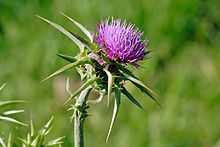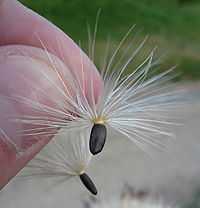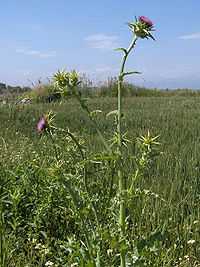Silybum marianum
| Milk thistle | |
|---|---|
 | |
| Scientific classification | |
| Kingdom: | Plantae |
| (unranked): | Angiosperms |
| (unranked): | Eudicots |
| (unranked): | Asterids |
| Order: | Asterales |
| Family: | Asteraceae |
| Tribe: | Cynareae |
| Genus: | Silybum |
| Species: | S. marianum |
| Binomial name | |
| Silybum marianum (L.) Gaertn. | |
| Synonyms | |
|
Carduus marianus L. | |





Silybum marianum has other common names include cardus marianus, milk thistle, blessed milk thistle, Marian Thistle, Mary Thistle, Saint Mary's Thistle, Mediterranean milk thistle, variegated thistle and Scotch thistle. This species is an annual or biannual plant of the Asteraceae family. This fairly typical thistle has red to purple flowers and shiny pale green leaves with white veins. Originally a native of Southern Europe through to Asia, it is now found throughout the world. The medicinal parts of the plant are the ripe seeds.
Description
It grows 30 to 200 cm tall, having an overall conical shape with an approx. 160 cm max. diameter base. The stem is grooved and more or less cottony. With the largest specimens the stem is hollow.
The leaves are oblong to lanceolate. They are either lobate or pinnate, with spiny edges. They are hairless, shiny green, with milk-white veins.
The flower heads are 4 to 12 cm long and wide, of red-purple colour. They flower from June to August in the North or December to February in the Southern Hemisphere ( Summer through Autumn ).
The bracts are hairless, with triangular, spine-edged appendages, tipped with a stout yellow spine.
The achenes are black, with a simple long white pappus, surrounded by a yellow basal ring.[1]
Distribution and habitat
Possibly native near the coast of south east England. It has been widely introduced outside its natural range, for example into Iran, North America, Australia, and New Zealand where it is considered an invasive weed. Cultivated fields for the production of raw-material for the pharmaceutical industry exists on a larger scale in Austria (Region Waldviertel), Germany, Hungary, Poland, China and Argentina. In Europe it is sown yearly in March–April. The harvest in 2 steps (cutting and threshing) takes place in August, about 2–3 weeks after the flowering.[citation needed]
Chemistry
Traditional milk thistle extract is made from the seeds, which contain approximately 4–6% silymarin.[2] The extract consists of about 65–80% silymarin (a flavonolignan complex) and 20–35% fatty acids, including linoleic acid.[3] Silymarin is a complex mixture of polyphenolic molecules, including seven closely related flavonolignans (silybin A, silybin B, isosilybin A, isosilybin B, silychristin, isosilychristin, silydianin) and one flavonoid (taxifolin).[3] Silibinin, a semipurified fraction of silymarin, is primarily a mixture of 2 diastereoisomers, silybin A and silybin B, in a roughly 1: 1 ratio.[3][4] In clinical trials silymarin has typically been administered in amounts ranging from 420–480 mg per day in two to three divided doses.[5] However higher doses have been studied, such as 600 mg daily in the treatment of type II diabetes and 600 or 1200 mg daily in patients chronically infected with hepatitis C virus.[6][7] An optimal dosage for milk thistle preparations has not been established. Milkthistle, along with dandelion and other extracts are often referred to as hangover cures as the bitter tincture helps organs rid toxins after heavy drinking.[8]
Herbal medicinal research
In herbalism, it is used in cases of liver diseases (cirrhosis, jaundice and hepatitis), gallbladder disease,[citation needed] and is claimed to protect the liver against poisons. Silibinin (syn. silybin, sylimarin I) is a hepatoprotective (antihepatotoxic), antioxidant (radical-scavenging agent), thus stabilizing and protecting the membrane lipids of the hepatocytes (liver cells). Silicristin inhibits the enzymes peroxidase and lipoxygenase. Silidianin is a plant growth regulator. A 2000 study of such claims by the AHRQ concluded that "clinical efficacy of milk thistle is not clearly established". However a more recent study did show activity against liver cancer cells in vitro.[9] A 2005 Cochrane Review considered thirteen randomized clinical trials which assessed milk thistle in 915 patients with alcoholic and/or hepatitis B or C virus liver diseases. They question the beneficial effects of milk thistle for patients with alcoholic and/or hepatitis B or C virus liver diseases and highlight the lack of high-quality evidence to support this intervention. Cochrane concluded that more good quality randomized clinical trials on milk thistle versus placebo are needed.
Its potent extract is used in medicine under the name silymarin (a flavonolignane complex consisting of silibinin A and B/silybin/silymarin I, isosilibinin A and B, silicristin/silymarin II, silidianin). Silibinin is used against poisoning by amanitas, such as the Death Cap (Amanita phalloides)[10] as well as in cerebral edema and acute hepatitis therapy.
Milk thistle has been grown as a medicinal plant in monastery gardens since ancient times. The seed is the part of the plant used medicinally.[citation needed]
Silybum marianum extract has antifungal effects, preventing the growth of dermatophyte more than saprophyte fungi.[11]
One pilot study showed that milk thistle may be as effective as fluoxetine in treatment of obsessive-compulsive disorder.[12]
A 2007 study found that silybum marianum blocked Hepatitis C virus (HCV) cell culture infection of human hepatoma cultures. A subsequent study in 2010 found that eight major compounds that comprise silybum, including seven flavonolignans—silybin A, silybin B, isosilybin A, isosilybin B, silychristin, isosilychristin, silydianin, and one flavonoid, taxifolin—are inhibitors of HCV RNA-dependent RNA polymerase.[13][14]
Silybum marianum extract is known for tumor inhibition and has been shown to stimulate neurons in culture and increase lymphocyte proliferation.[15]
Protection from Toxin-induced liver damage
Research suggests that milk thistle extracts both prevent and repair damage to the liver from toluene and/or xylene. Workers who had been exposed to vapors from toluene and/or xylene for 5–20 years were given either a standardized milk thistle extract (80% silymarin) or placebo for 30 days.[16] The workers taking the milk thistle extract showed significant improvement in liver function tests (ALT and AST) and platelet counts vs. the placebo group.
The efficacy of silymarin in preventing drug-induced liver damage in patients taking psychotropic drugs long-term has been investigated.[17]
A clinical trial in humans showed that silymarin (140 mg orally 3 times daily) was not effective when used for 1 year in combination with ursodeoxycholic acid (UDCA) for the treatment of primary biliary cirrhosis.[18] A study in baboons indicated that continuous intragastric infusion of silymarin retarded the development of alcohol-induced hepatic fibrosis over a 3-year period. The authors suggested that the failure of silymarin to show beneficial effects in other clinical trials may have been due to poor compliance with treatment, resulting in insufficient dosing.[19]
In a 2010 study published in the journal Cancer, milk thistle was associated with a trend towards reducing the liver damaging effects of chemotherapy in a randomized double-blind placebo controlled study of 50 children.[20]
Amanita mushroom poisoning
There has been no controlled clinical study of any treatment suggested for mushroom poisoning.[10] Amanita Phalloides poisoning is relatively rare, and such hard evidence as is available comes from animal studies, e.g.,.[21] The efficacy of thirty different treatments was analyzed in a retrospective study of 205 cases of Amanita phalloides (death cap) mushroom poisoning.[22] Both [penicillamine] and hyperbaric oxygen independently contributed to a higher rate of survival. When silybin [silibinin] was added to the penicillamine treatment, survival was increased even more. In another 18 cases of death cap poisoning, a correlation was found between the time elapsed before initiation of silybin therapy, and the severity of the poisoning. The data appear to indicate that severe liver damage in Amanita phalloides poisoning can be prevented effectively when administration of silybin begins within 48 hours of mushroom intake.[23] Case control studies also suggest that silibinin reduces mortality from mushroom poisoning.[10]
Other uses
Beside benefits for liver disease, other unproven treatment claims include:[24]
- Lowering cholesterol levels[25]
- Reducing insulin resistance in people with type 2 diabetes who also have cirrhosis,[25][26]
- Reducing the growth of cancer cells in breast, cervical, and prostate cancers.[27]
- Clinical study has shown that liver function tests can be improved in active hepatitis patients.[28]
- Alzheimer's Disease prevention or treatment.[29][30][31][32]
Use as food
Milk thistle has also been known to be used as food.[33] Around the 16th century the milk thistle became quite popular and almost all parts of it were eaten. The roots can be eaten raw or boiled and buttered or par-boiled and roasted. The young shoots in spring can be cut down to the root and boiled and buttered. The spiny bracts on the flower head were eaten in the past like globe artichoke, and the stems (after peeling) can be soaked overnight to remove bitterness and then stewed. The leaves can be trimmed of prickles and boiled and make a good spinach substitute or they can also be added raw to salads.[citation needed]
Animal toxicity
Because of potassium nitrate content, the plant has been found to be toxic to cattle and sheep. When potassium nitrate is eaten by ruminants, the bacteria in animal's stomach breaks the chemical down, producing a nitrite ion. Nitrite ion then combines with hemoglobin to produce methaemoglobin, blocking the transport of oxygen. The result is a form of oxygen deprivation.[34]
See also
References
- ↑ Rose, Francis (1981). The Wild Flower Key. Frederick Warne. pp. 388–9. ISBN 0-7232-2419-6.
- ↑ Greenlee, H.; Abascal, K.; Yarnell, E.; Ladas, E. (2007). "Clinical Applications of Silybum marianum in Oncology". Integrative Cancer Therapies 6 (2): 158–65. doi:10.1177/1534735407301727. PMID 17548794.
- ↑ 3.0 3.1 3.2 Kroll, D. J.; Shaw, H. S.; Oberlies, N. H. (2007). "Milk Thistle Nomenclature: Why It Matters in Cancer Research and Pharmacokinetic Studies". Integrative Cancer Therapies 6 (2): 110–9. doi:10.1177/1534735407301825. PMID 17548790.
- ↑ Hogan, Fawn S.; Krishnegowda, Naveen K.; Mikhailova, Margarita; Kahlenberg, Morton S. (2007). "Flavonoid, Silibinin, Inhibits Proliferation and Promotes Cell-Cycle Arrest of Human Colon Cancer". Journal of Surgical Research 143 (1): 58–65. doi:10.1016/j.jss.2007.03.080. PMID 17950073.
- ↑ Rainone, Francine (2005). "Milk Thistle". American Family Physician 72 (7): 1285–8. PMID 16225032.
- ↑ Huseini, H. Fallah; Larijani, B.; Heshmat, R.; Fakhrzadeh, H.; Radjabipour, B.; Toliat, T.; Raza, Mohsin (2006). "The efficacy ofSilybum marianum (L.) Gaertn. (silymarin) in the treatment of type II diabetes: A randomized, double-blind, placebo-controlled, clinical trial". Phytotherapy Research 20 (12): 1036–9. doi:10.1002/ptr.1988. PMID 17072885.
- ↑ Gordon, Adam; Hobbs, Daryl A; Bowden, D Scott; Bailey, Michael J; Mitchell, Joanne; Francis, Andrew JP; Roberts, Stuart K (2006). "Effects ofSilybum marianumon serum hepatitis C virus RNA, alanine aminotransferase levels and well-being in patients with chronic hepatitis C". Journal of Gastroenterology and Hepatology 21 (1 Pt 2): 275–80. doi:10.1111/j.1440-1746.2006.04138.x. PMID 16460486.
- ↑ Pugh, Becky (5 December 2008). "The Best Hangover Remedies Tested". The Telegraph. Retrieved 2 December 2012.
- ↑ Lah, John J; Cui, Wei; Hu, Ke-Qin (2007). "Effects and mechanisms of silibinin on human hepatoma cell lines". World Journal of Gastroenterology 13 (40): 5299–305. PMID 17879397. Lay summary – ScienceDaily (November 15, 2007).
- ↑ 10.0 10.1 10.2 Saller, R.; Brignoli, R.; Melzer, J.; Meier, R. (2008). "An Updated Systematic Review with Meta-Analysis for the Clinical Evidence of Silymarin". Forschende Komplementärmedizin / Research in Complementary Medicine 15: 9. doi:10.1159/000113648.
- ↑ Salehi, M.; Hasanloo, T.; Mehrabian, S.; Farahmand, S. (2011). "Effects of Silybum marianum (L.) Gaertn seeds extract on dermatophytes and saprophytes fungi in vitro compare to clotrimazol". Pharmaceutical Sciences 16 (4): 203–10.
- ↑ Sayyah, Mehdi; Boostani, Hatam; Pakseresht, Siroos; Malayeri, Alireza (2010). "Comparison of Silybum marianum (L.) Gaertn. With fluoxetine in the treatment of Obsessive−Compulsive Disorder". Progress in Neuro-Psychopharmacology and Biological Psychiatry 34 (2): 362–5. doi:10.1016/j.pnpbp.2009.12.016. PMID 20035818.
- ↑ Polyak, Stephen J.; Morishima, Chihiro; Lohmann, Volker; Pal, Sampa; Lee, David Y. W.; Liu, Y.; Graf, Tyler N.; Oberlies, Nicholas H.; Alter, Harvey J. (2010). "Identification of hepatoprotective flavonolignans from silymarin". Proceedings of the National Academy of Sciences 107 (13): 5995–9. Bibcode:2010PNAS..107.5995P. doi:10.1073/pnas.0914009107. JSTOR 25665103. PMC 2851903. PMID 20231449.
- ↑ Ahmed–Belkacem, Abdelhakim; Ahnou, Nazim; Barbotte, Laetitia; Wychowski, Czeslaw; Pallier, Coralie; Brillet, Rozenn; Pohl, Ralf–Torsten; Pawlotsky, Jean–Michel (2010). "Silibinin and Related Compounds Are Direct Inhibitors of Hepatitis C Virus RNA-Dependent RNA Polymerase". Gastroenterology 138 (3): 1112–22. doi:10.1053/j.gastro.2009.11.053. PMID 19962982.
- ↑ Wilasrusmee, Chumpon; Kittur, Smita; Shah, Gaurang; Siddiqui, Josephine; Bruch, David; Wilasrusmee, Skuntala; Kittur, Dilip (2002). "Immunostimulatory effect of Silybum Marianum (milk thistle) extract". Medical Science Monitor 8 (11): BR439–43. PMID 12444368.
- ↑ Szilárd, S; Szentgyörgyi, D; Demeter, I (1988). "Protective effect of Legalon in workers exposed to organic solvents". Acta medica Hungarica 45 (2): 249–56. PMID 3073356.
- ↑ Palasciano, Giuseppe; Portincasa, Piero; Palmieri, Vincenzo; Ciani, Daniela; Vendemiale, Gianluigi; Altomare, Emanuele (1994). "The effect of silymarin on plasma levels of malon-dialdehyde in patients receiving long-term treatment with psychotropic drugs". Current Therapeutic Research 55 (5): 537–45. doi:10.1016/S0011-393X(05)80184-5.
- ↑ Angulo, P; Patel, T; Jorgensen, RA; Therneau, TM; Lindor, KD (2000). "Silymarin in the Treatment of Patients with Primary Biliary Cirrhosis with a Suboptimal Response to Ursodeoxycholic Acid". Hepatology 32 (5): 897–900. doi:10.1053/jhep.2000.18663. PMID 11050036.
- ↑ Lieber, Charles S.; Leo, Maria A.; Cao, Qi; Ren, Chaoling; Decarli, Leonore M. (2003). "Silymarin Retards the Progression of Alcohol-Induced Hepatic Fibrosis in Baboons". Journal of Clinical Gastroenterology 37 (4): 336–9. doi:10.1097/00004836-200310000-00013. PMID 14506392.
- ↑ Ladas, Elena J.; Kroll, David J.; Oberlies, Nicholas H.; Cheng, Bin; Ndao, Deborah H.; Rheingold, Susan R.; Kelly, Kara M. (2010). "A randomized, controlled, double-blind, pilot study of milk thistle for the treatment of hepatotoxicity in childhood acute lymphoblastic leukemia (ALL)". Cancer 116 (2): 506–13. doi:10.1002/cncr.24723. PMC 3542639. PMID 20014183.
- ↑ Influence of zinc, D-penicillamine and oxygen on poisoning with Amanita phalloides. Zinc accelerates liver regeneration and prevents the depletion of brain noradrenaline caused by the mushroom.Floersheim GL, Bianchi L, Probst A, Chiodetti N, Honegger CG.Agents Actions. 1984 Jan;14(1):124-30. URL: http://www.ncbi.nlm.nih.gov/pubmed/6702510
- ↑ Floersheim, GL; Weber, O; Tschumi, P; Ulbrich, M (1982). "Die klinische Knollenblätterpilzvergiftung (Amanita phalloides): Prognostische Faktoren und therapeutische Maßnahmen" [Clinical death-cap (Amanita phalloides) poisoning: prognostic factors and therapeutic measures. Analysis of 205 cases]. Schweizerische Medizinische Wochenschrift (in German) 112 (34): 1164–77. PMID 6291147.
- ↑ Hruby, K; Fuhrmann, M; Csomos, G; Thaler, H (1983). "Pharmacotherapy of Amanita phalloides poisoning using silybin". Wiener klinische Wochenschrift 95 (7): 225–31. PMID 6410590.
- ↑ Ramasamy, Kumaraguruparan; Agarwal, Rajesh (2008). "Multitargeted therapy of cancer by silymarin". Cancer Letters 269 (2): 352–62. doi:10.1016/j.canlet.2008.03.053. PMC 2612997. PMID 18472213.
- ↑ 25.0 25.1 Beckerman, James (June 22, 2012). "Milk Thistle: Benefits and Side Effects". WebMD.
- ↑ Deep, Gagan; Agarwal, Rajesh (2010). "Antimetastatic efficacy of silibinin: Molecular mechanisms and therapeutic potential against cancer". Cancer and Metastasis Reviews 29 (3): 447–63. doi:10.1007/s10555-010-9237-0. PMID 20714788.
- ↑ National Center for Complementary and Alternative Medicine. "Milk Thistle". National Institutes of Health. – General information on milk thistle
- ↑ Buzzelli, G; Moscarella, S; Giusti, A; Duchini, A; Marena, C; Lampertico, M (1993). "A pilot study on the liver protective effect of silybin-phosphatidylcholine complex (IdB1016) in chronic active hepatitis". International journal of clinical pharmacology, therapy, and toxicology 31 (9): 456–60. PMID 8225695.
- ↑ Murata, Nakaba; Murakami, Kazuma; Ozawa, Yusuke; Kinoshita, Noriaki; Irie, Kazuhiro; Shirasawa, Takuji; Shimizu, Takahiko (2010). "Silymarin Attenuated the Amyloid β Plaque Burden and Improved Behavioral Abnormalities in an Alzheimer's Disease Mouse Model". Bioscience, Biotechnology, and Biochemistry 74 (11): 2299–306. doi:10.1271/bbb.100524. PMID 21071836.
- ↑ Lu, P; Mamiya, T; Lu, LL; Mouri, A; Zou, LB; Nagai, T; Hiramatsu, M; Ikejima, T; Nabeshima, T (2009). "Silibinin prevents amyloid β peptide-induced memory impairment and oxidative stress in mice". British Journal of Pharmacology 157 (7): 1270–7. doi:10.1111/j.1476-5381.2009.00295.x. PMC 2743846. PMID 19552690.
- ↑ Yin, Fei; Liu, Jianhui; Ji, Xiuhong; Wang, Yanwen; Zidichouski, Jeffrey; Zhang, Junzeng (2011). "Silibinin: A novel inhibitor of Aβ aggregation". Neurochemistry International 58 (3): 399–403. doi:10.1016/j.neuint.2010.12.017. PMID 21185897.
- ↑ Lu, P.; Mamiya, T.; Lu, L. L.; Mouri, A.; Niwa, M.; Hiramatsu, M.; Zou, L. B.; Nagai, T.; Ikejima, T.; Nabeshima, T. (2009). "Silibinin Attenuates Amyloid β25–35 Peptide-Induced Memory Impairments: Implication of Inducible Nitric-Oxide Synthase and Tumor Necrosis Factor-α in Mice". Journal of Pharmacology and Experimental Therapeutics 331 (1): 319–26. doi:10.1124/jpet.109.155069. PMID 19638571.
- ↑ "Milk Thistle". Manitoba Agriculture Food and Rural Initiatives. Retrieved 2 December 2012.
- ↑ http://tncweeds.ucdavis.edu/esadocs/documnts/silymar.html[]
Further reading
- Milk Thistle: Effects on Liver Disease and Cirrhosis and Clinical Adverse Effects AHRQ report
- PDR for Herbal Medicines, Third Edition (ISBN 1-56363-512-7)
- Everist, S.L. (1974) Poisonous Plants of Australia Revised edition. pp. 185–187. (Angus & Robertson: Sydney) ISBN 0-207-14228-9
- Parsons, W.T. & Cuthbertson, E.G. (2001) Noxious Weeds of Australia. 2nd edn. pp. 229–233 (CSIRO: Collingwood) ISBN 0-643-06514-8.
- Rambaldi, Andrea; Jacobs, Bradly P; Gluud, Christian (2007). "Milk thistle for alcoholic and/or hepatitis B or C virus liver diseases". In Rambaldi, Andrea. Cochrane Database of Systematic Reviews (4): CD003620. doi:10.1002/14651858.CD003620.pub3. PMID 17943794.
- UC Davis profile
| Wikimedia Commons has media related to Silybum marianum. |